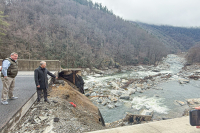Helene damage coming into focus in Waynesville
 Helene’s floodwaters in Waynesville caused the most damage to businesses in Frog Level. Cory Vaillancourt photo
Helene’s floodwaters in Waynesville caused the most damage to businesses in Frog Level. Cory Vaillancourt photo
Like much of Haywood County, Waynesville wasn’t affected by Hurricane Helene as badly as many other Western North Carolina communities, but businesses, residents and the town still incurred millions in costly damages that will take time to fix.
Town government was hit across nearly all departments and lost property, vehicles, infrastructure and park facilities.
“We’ve developed a priority matrix of our urgent/non-urgent needs and also developed pricing,” said Town Manager Rob Hites during a Nov. 12 meeting of the Waynesville Town Council.
Staff and contractors are still working to clean up piles of debris left after Helene struck the region in the early morning hours of Sept. 27.
Southern Debris Removal is almost finished with its first pass through the town and will make two more passes with the understanding that some people are only just now able to reenter their homes and will begin gutting them where necessary, creating more debris in the process.
As of Nov. 8, SDR had already collected and removed around 168 cubic yards of debris per day, totaling 3,368 cubic yards of debris. That’s around 91,000 cubic feet, or enough to cover a football field to a height of nearly two feet.
Related Items
The Haywood County Sheriff’s Office reported removing 9,119 cubic yards of debris as of Nov. 12. Countywide, 8,625 FEMA registrations have resulted in more than $11.9 million in disbursements to those impacted by the storm.
Total town damages, according to Hites’ presentation, are $2.13 million — and growing. For scale, the town’s all-funds annual budget is around $35 million.
“And that’s to the public sector,” he said. “That’s not private sector damage, that’s damage to the city itself — to the city parks, buildings, bridges, sewer lines.”
The cost will largely be reimbursed by FEMA, Hites said, with a check coming for urgent needs in the next few months, and a check coming for non-urgent needs a few months later. Hites’ list of damages is long, and provides gripping insight into what, exactly, transpired as Helene inundated Hazelwood, Frog Level and outlying reaches of the town.
REAL PROPERTY
The town’s finance department and one of its fire stations, located at 280 Georgia Ave., were flooded. ServiceMaster has completed building restoration work, and the town is currently drafting bid specifications to complete the project, which will include bringing the bathrooms up to ADA compliance. The cost is estimated at $204,000, not including lost equipment and furnishings.
The old armory at 44 Boundary St. also flooded when Richland Creek rose dramatically late in the morning, roared through Frog Level and destroyed several businesses there. The armory has been completely restored and reopened on Oct. 28. Total cost is estimated at $44,000.
Rain was also able to penetrate the roof of town hall at 9 South Main Street, leaving behind significant moisture and causing issues with humidity that have allowed mold and mildew to spread. An estimate, according to the report, is forthcoming.
VEHICLES
Four police department vehicles were lost in the flood, a 2022 Dodge Durango, a 2023 Ford Interceptor, a 2019 Chevy Tahoe and a 2017 Chevy Silverado, totaling $164,000. The town has already submitted claims to its insurer and ordered replacements using fund balance while awaiting FEMA reimbursement.
A 2015 Ford F-250 belonging to the fire department was also lost but a replacement has been purchased. The cost, including upfit, is $77,000.
INFRASTRUCTURE
A pump house providing water service to 800 residents near Camp Branch Road was damaged; however, the town’s public works department repaired it in-house in order to restore service as quickly as possible. Material and equipment costs for the work are estimated at $80,000.
Timicua Trail Road, above the pump house, was also damaged by a landslide and by erosion, with an estimated cost of $95,000. WNC Paving has been contracted to repair the road by the end of the month.
The town’s old wastewater treatment plant took on mud, with an estimated $450,000 in damages. Hites’ report says the town was hoping to complete its new wastewater treatment plant ahead of schedule; however, Helene has set the project back by perhaps three months. The new plant is still on track to be ready by late spring 2025.
The electric substation at Smathers Street, swallowed up by Richland Creek, has $18,000 in damage to the fencing surrounding it. Estimates for battery and breaker cabinet damage aren’t yet available.
Probably the most visible — and irritating — storm damage in Waynesville is to the Depot Street bridge, which is considered structurally compromised by Mattern & Craig Engineers. With ongoing construction on Russ Avenue and few other ways in and out of Waynesville to and from the north, the bridge’s closure has resulted in heavy traffic, especially during rush hour.
An engineering study has been used to create a design for permanent repairs to the bridge, and the engineering firm will inspect final repairs, taking a huge burden off town staff. There is no firm timeline yet, per staff report.
Because the project is considered urgent, the town will not have to comply with bid requirements to get the work done. The current estimate for repairs is $330,000.
A sewer main at Richland Creek will cost $325,000, with Buckeye Construction emerging as the top bidder.
All told, infrastructure damage totals just under $1.3 million.
PARKS AND RECREATION
As Richland Creek made its way through Frog Level and down the railroad tracks toward Haywood Builders Supply, topping a bridge on Russ Avenue and rising right up to Mountain Creek Apartments, it eventually spilled out onto the Waynesville Recreation Center’s ballfields, damaging several amenities there.
“We are continuing the debris removal with SDR, and they’re continuing to get debris up as the weeks go by,” said Luke Kinsland, Waynesville’s Parks and Recreation director. “Right now, our strategy is to assess costs, obtain bids as far down as fencing [and] electrical, and assess what can be restored and repaired or what needs a complete demo and rebuild.”

Athletic fields at the Waynesville Recreation Center were transformed into a small lake by Hurricane Helene on the afternoon of Sept. 27. Cory Vaillancourt photo
The greenway section along Richland Creek incurred damage not only to the natural surfaces but also to the asphalt. Some light grading will take care of the natural surfaces, but the asphalt areas will need to be repaved.
The dog park was destroyed, so Kinsland is proposing to move it out of the floodway to where the sand volleyball courts are, right off Howell Mill Road, at a cost of $80,000. The volleyball courts in turn should be moved to BI-LO Park off East Street, where damaged restrooms should not be rebuilt because they’d still be vulnerable to flood damage.
The Vance Street softball field and its restrooms were heavily damaged, necessitating a rebuild of the field, press box, scoreboard and fencing, although the restrooms weren’t structurally compromised.
Some of the most heavily impacted recreation facilities weren’t at the rec center — they were in Hazelwood.
Hazelwood Park and Dutch Fisher Field, badly in need of upgrades even before Helene, sustained substantial damage to bleachers, dugouts, fencing, electrical systems and the press box. Kinsland’s report says building foundations were heavily undercut by floodwaters.
“What we hope to do is go out to bid soon and do an RFQ for engineering and design services to kind of get us back into rebuild and see what FEMA will reimburse us for,” Kinsland said, adding that he hoped to see flood-mitigated facilities that are “not bulletproof but hold up better to future flooding” as the facilities are still in the floodplain.
“Our hope is to have the field ready by the spring of 2025,” Kinsland said.
Kinsland has requested the Army Corps of Engineers analyze Richland Creek for debris removal and possible restoration of its banks. Total cost estimates for everything else top $264,000.
PRIVATE PROPERTY
As a national flood insurance program community, Waynesville had to conduct damage assessments of private residences and private non-residential structures in the two weeks following Helene.
“They’re used not just to collect data but it also gets us on the street, on the ground, trying to connect people to resources,” said Development Services Director Elizabeth Teague.
In addition to maintaining NFIP compliance, the damage assessments also identify unsafe structures, inform long term planning and help expedite permitting.
The amount of data collected by the town, according to Teague, “astounded” North Carolina Emergency Management and FEMA officials, with the focus of that data on telltale areas — Depot and Commerce streets in Frog Level, Smathers and Killian streets near Sulphur Springs, Harris Street near the rec center and Camp Branch Road, on the town’s southeastern flank.
Rebe Street, just south of the Richland Creek Bridge over Russ Avenue, notched the highest watermark of the storm, at 6 feet. Killian Street was a close second.
Properties built to base flood elevation (BFE) standards plus 1 foot seem to have suffered less damage than other structures, according to a development services department presentation. Structures built prior to 1983, when floodplain regulations commenced, seem to have suffered more.
Development services department staff assessed 446 structures that displayed visible damage. Of the total, 302 were residential and 144 were non-residential; 325 were at least partially within the regulatory 100-year floodplain with 17 outside that flood plain; 342 showed at least some damage and 62 sustained damages of between 30% and 50%.
Of particular concern are the 22 structures — 18 of them in the 100-year floodplain or about 6.5% of the total assessed — that were designated “substantially damaged,” which means damaged to more than 50% of the building’s value. A majority of those structures presented watermarks between 3 and 5 feet above the ground.
Substantially damaged residential structures must be brought into full compliance with town regulations, including floodplain regulations, if they’re to be restored. That could mean elevating them or moving them if possible.
“There are a couple of places where people may not be able to build back where they originally had their home,” Teague said. “There’s just a handful of those, and again, we’re trying to be really sensitive and they’re working through their FEMA representative to see what their process is to do a potential buyout.”
Substantially damaged commercial structures have an additional option, floodproofing, which could be a welcome alternative in Waynesville’s hard-hit commercial districts.
In Frog Level, four commercial structures were designated as substantially damaged, mostly near the intersection of Depot and Commerce streets but also including Mia Salon on Water Street. All other buildings in that cluster suffered moderate damage of varying degrees, with the force of the flood ripping doors off hinges, scouring mortar from between courses of brick and leaving watermarks of up to 4 feet above ground.
Miraculously, Richland Creek didn’t inflict as much damage on Panacea Coffee Company and Frog Level Brewing as one might have suspected while watching floodwaters roil down Commerce Street.
Those buildings, built in 1930 and 1918 respectively, are somewhat elevated and are slab-on-grade. Both businesses reopened quickly after the storm.
“Our theory is that because those buildings were built so close to the creek and were from so long ago, even though most people we talk to say we haven’t seen a lot of this type of flooding ever in Waynesville, we have a feeling the people who built those buildings had seen some level of flooding like that,” said Alex Mumby, a land use administrator for the town.
Waynesville Plaza fared somewhat better than Frog Level; however, two commercial structures there were substantially damaged as some areas saw 2 feet of water. Kobe Express has already moved from that location and the building will be demolished, Mumby said. The status of Lilly’s Nails was unclear; however, the business is also reported to have lost substantial amounts of inventory and equipment.
Suppositions that the Mountain Creek Apartments, opened in 2023 just across the creek from Waynesville Plaza, could have somehow contributed to flooding in the plaza aren’t supported by flood maps, per Mumby.
Hazelwood’s compact core, in turn, fared somewhat better than Waynesville Plaza. Despite the early presence of standing water on Hazelwood Avenue, most of it never made it into businesses. The water that did more often than not came in through the roof, damaging inventory — the biggest casualty in Hazelwood.
Blue Ridge Books took the worst of the water, warping wooden flooring.
Again, slab-on-grade buildings or slightly elevated structures fared significantly better.
Teague said that her department would be bringing recommendations for changing or amending floodplain regulations locally, based on what else they learn from the storm. Although the state is pushing for the adoption of BFE plus 4 feet standards, Teague said the town’s BFE plus 1 foot ordinance is working but that a BFE plus 2 feet would be beneficial.
Any recommended changes would first be heard at a meeting of the town’s planning board.













